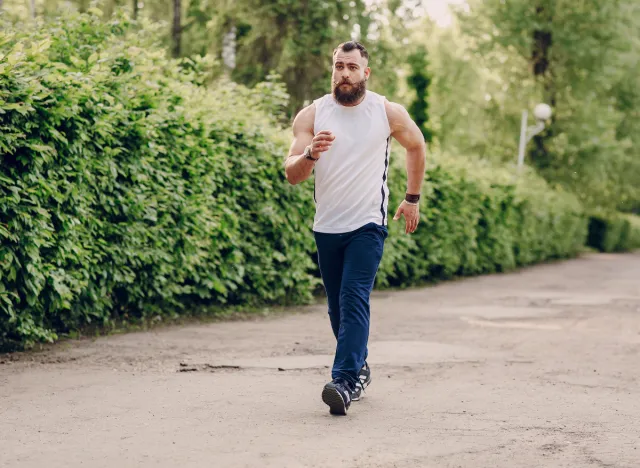How To Use the 'Run/Walk' Method To Lose Weight

If you're a walker or runner, we're here to suggest a great way to spruce up your routine. The "run/walk" method is an excellent form of cardio to help you lose weight and build endurance. And, as the name suggests, it calls for you to alternate between walking and running, which will make the time go by faster.
"The core idea behind this is that it helps you build up to running for longer durations, even if you can't run for very long yet," explains Domenic Angelino, CPT, from Trainer Academy. "When doing the run/walk method, instead of stopping your workout when you run out of steam during a run, start walking. Walk at a pace that is easy to maintain and allows you to recover. Then, when you feel ready, start running again."
You'll continue your cardio workout this way until you can finish your goal distance. Before you know it, less of your strides will be walking, and your running endurance will totally move up a notch or two. The goal is to improve your running endurance over time to a point where you'll eventually run the entire distance.
If you're ready to get your walk/run game face on, let's explore how this method can help you lose weight, tips to get started, and a sample routine.
How can the run/walk method help you lose weight?

You'll burn more calories by lengthening your workout duration and increasing the intensity. Running, in general, can burn more calories than walking. In fact, according to Harvard Health Publishing, a 155-pound individual can burn around 288 calories from running for 30 minutes at 5mph, compared to burning 133 calories from walking at 3.5 mph.
When all is said and done, the greater the number of calories you torch, the more weight will come off… now and in the future. See where we're going with this?
"[The run/walk method] helps you gradually get used to running for longer durations. It sets you up so that your future workouts will be more productive, too," explains Angelino.
If you get bored easily, combining the two forms of cardio can make every single workout a bit different, especially if you change your route and terrain. And, let's be honest: You're more likely to stick with a workout regimen that keeps you challenged and interested, and you can do it wherever you are. If you have a treadmill, you can even keep up with it indoors whenever inclement weather occurs.
How to start your run/walk workout:

Angelino offers a few tips on starting your new run/walk workout routine.
1. Consider aiming for a greater distance or running speed.
Each time you head out for a run/walk, try to go a bit further and faster. Don't be afraid to "push the boundaries."
Angelino stresses, "If you go this route, it can be helpful to incorporate the run/walk method to gradually build up your ability to run for your new distance or at your new speed."
2. Opt for walking over a slow jog.
Be all-in for whichever form of cardio you perform during the workout. This means that if you're going to walk, keep it at a walk and not a slow jog.
Angelino says, "Walking is preferable over a slow jog because [it's] much less fatiguing."
Your goal here is to work up to a full run to get the most benefit from each workout. Look at your walking intervals as recovery time. The better your quality of recovery, the more intensity you can put into the runs.
3. Challenge yourself, but know you can tweak along the way.
You can structure your run/walk routines with set intervals or base them on your current mood. The beauty of this method is that you can reduce your activity to a walk when you're fatigued and run again when your body feels ready. Remember that the overall goal is to work up to a full run, so challenge yourself, but feel free to tweak each workout to suit your body.
"You can simply walk at the end of your workout for as long as you want," Angelino suggests. "Walking for another five, 10, 15, or 20 minutes can help you burn even more calories. It's easier to find the motivation to walk when you're tired than it is to find the motivation to run."
Here are a few sample run/walk workouts to help beginners get started:

Choose any beginner-friendly plan, and go for it. This regimen was also curated so you can perform any of these workouts for 30 days, then move on to the next workout for 30 days, and so on.
"It helps you gradually build up your running endurance and will make sure that each month your workouts help you burn more calories than the previous month," says Angelino.
Workout #1: Just starting out
- Monday: Run for 5 minutes, walk for 10 minutes for a total of 45 minutes
- Tuesday: Rest
- Wednesday: Run for 5 minutes, walk for 10 minutes for a total of 45 minutes
- Thursday: Rest
- Friday: Run for 5 minutes, walk for 10 minutes for a total of 60 minutes
- Saturday: Rest
- Sunday: Run for 5 minutes, walk for 10 minutes for a total of 30 minutes
Workout #2: 30 days of recent training experience
- Monday: Run for 10 minutes, walk for 10 minutes for a total of 40 minutes
- Tuesday: Rest
- Wednesday: Run for 10 minutes, walk for 10 minutes for a total of 40 minutes.
- Thursday: Rest
- Friday: Run for 10 minutes, walk for 10 minutes for a total of 60 minutes
- Saturday: Rest
- Sunday: Run for 10 minutes, walk for 10 minutes for a total of 40 minutes
Workout #3: 60 days of recent training experience
- Monday: Run for 10 minutes, walk for 5 minutes for a total of 45 minutes
- Tuesday: Rest
- Wednesday: Run for 10 minutes, walk for 5 minutes for a total of 45 minutes
- Thursday: Rest
- Friday: Run for 10 minutes, walk for 5 minutes for a total of 60 minutes
- Saturday: Rest
- Sunday: Run for 10 minutes, walk for 5 minutes for a total of 30 minutes
Workout #4: 90 days of recent training experience
- Monday: Run for 15 minutes, walk for 5 minutes for a total of 40 minutes
- Tuesday: Rest
- Wednesday: Run for 15 minutes, walk for 5 minutes for a total of 40 minutes
- Thursday: Rest
- Friday: Run for 15 minutes, walk for 5 minutes for a total of 60 minutes
- Saturday: Rest
- Sunday: Run for 15 minutes, walk for 5 minutes for a total of 40 minutes









